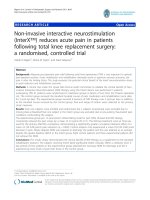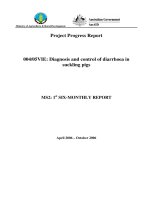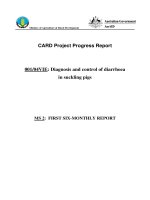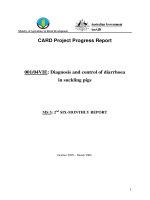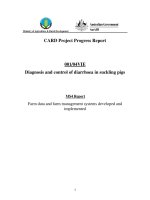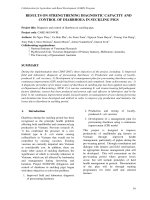ACUTE DIARRHOEA IN CHLDREN
Bạn đang xem bản rút gọn của tài liệu. Xem và tải ngay bản đầy đủ của tài liệu tại đây (2.12 MB, 35 trang )
ACUTE DIARRHOEA IN CHILDREN
Epidemiology and
Definition
Definition
• Acute diarrhea is defined as the abrupt onset
of 3 or more loose stools per day and lasts no
longer than 14 days
Epidemiology
• Diarrhoeal disease is the second leading cause of death in
children under five years old
• Responsible for killing around 525 000 children every year.
• Globally, there are nearly 1,7 billion cases of childhood
diarrhoeal disease every year.
• Widespread throughout developing countries and in lowincome countries
• Among the notifiable diseases in Viet Nam, diarrheal diseases
are one of the top ten causes of morbidity and mortality in
Viet Nam recently. In 2009 there were 930.496 cases with
four fatal cases reported.
Causes and risk factors for
Acute diarrhoea (AD)
Host factors
Biological factors increase
susceptibility to AD
Age: The incidence of AD peaks
at around age 6-11 months,
remains high through 24 months
and then decreases
Failure to get immunised against
rotavirus
Failure of measles vaccination;
measles predisposes to diarrhoea
by damage to the intestinal
epithelium and immune
suppression
Malnutrition is associated with an
increased incidence, severity and
duration of diarrhoea.
Immunodeficiency: measles, HIV and
etc
Behavioral factors increase the
risk of AD
Not breastfeeding
exclusively for 6 months
Using infant feeding bottles:
they easily become
contaminated with diarrhoea
pathogens and are difficult to
clean
Not washing hands after
defecation, handling faeces
or before handling food
Environmental factors
These include:
Seasonality:The incidence of AD has seasonal variation in many
regions
In temperate climates, viral diarrhoea peaks during winter
whereas bacterial diarhoea occurs more frequently during the
warm season
In tropical areas, viral and bacterial diarrhoeal occur throughout
the year with increased frequency during drier, cooler months.
Poor domestic and environmental sanitation especially unsafe
water
Poverty
Common causes of AD
More than 20 viruses, bacteria and parasites have been associated with acute diarhoea
Worldwide, rotavirus is the commonest cause of severe dehydrating diarrhoea causing 0.6 million
deaths annually, 90% of which occur in developing countries
The incidence of specific pathogens varies between developed and developing countries
In developed countries, about 40% of AD cases are due to rotavirus and only 10-20% are of bacterial
origin while in developing countries, 50-60% are caused by bacteria while 15-25% are due to rotavirus
Other viral
agents
Enteric
adenoviruses
Astrovirus
Human
calciviruses
(norovirus and
sapovirus)
Bacteria
•
E. coli (EAEC,
EPEC, EIEC)
Shigella spp
Staphylococcus
spp
Salmonella spp
Yersinia
enterocolitica
Campylobacter
jejuni
Vibrio cholera
Parasites
Entamoeba
histolitica
Girdia lamblia
Cryptosporidium
Trichuris
trichuria
Strongyloides
stercoralis
Pathophysiology of acute diarrhea
When diarrhea occurs,
the ability to absorb
water in the intestinal
tract decreases, leading
to the excretion of water
in the stool.
Pathophysiology mechanism of diarrhea
Pathophysiology mechanism
Type of diarrhea
A stimulating substance ( e.g laxatives or Secretory diarrhea
a bacterial toxin) changes active ion
transport in the intestine by either
decreased sodium absorption or
increased chloride secretion
Change in intestinal motility (e.g by
overgrowth of bacteria)
Increase in intestinal luminal osmolarity
due to poorly absorbed substances
Increase in tissue hydrostatic pressure
due to inflammatory diseases of the
gastrointestinal tract
Altered intestinal motility
Osmotic diarrhea
Exudative adiarrhea
CLINICAL and PARACLINICAL
Assess the child with diarrhoea for
signs of dehydration
o ASK: Does the child have diarrhoea?
o ASK: For how long has the child had diarrhoea?
o ASK: Is there blood in stool?
o LOOK at the child’s general condition. Is the child lethargic or
unconscious? Restless and irritable
o LOOK for sunken eyes
o OFFER the child fluid. Is the child not able to drink or is drinking poorly?
Drinking eagerly, thirsty?
o PINCH the skin of the abdomen . Does it go back: very slowly (longer than
2 seconds) or slowly? Immediately?
Signs of Dehydration
Signs Of Dehydration
Pinch the skin slowly
Sunken eyes
Pinch the skin - slowly
Signs Of Dehydration
Children Drink water
eagerly
Sunken Fontanelle
Classify the
child's level of
dehydration
CLINICAL
Signs attached:
•
•
•
Frequent passage of small liquid stools that contain visible
blood(shigellosis),with or without mucous(cholera)
Sudden vomiting and abdominal cramping
Fever and anorexia
PARACLINICAL
o FBC: Usually normal; elevated WBC
count and granulocytes if sepsis is
present
o
Serum electrolytes, urea , creatinine :
Usually normal; abnormal if severe
dehydration is present
PARACLINICAL
o Stool microscopy:
+Usually normal; presence of WBCs suggests infection with an invasive cytotoxinproducing organism such as Salmonella , Shigella , or Yersinia enterocolitica
+The test should be considered in children with bloody diarrhoea
o Stool culture
+ Negative
+ Rarely required. Stool cultures should be considered in children with bloody
diarrhoea to exclude bacterial causes
PARACLINICAL
o Enzyme immunoassay (EIA) for detection of viral antigen
+May show the offending viral pathogen (rotaviruses, noroviruses, astroviruses,
adenoviruses)
+Rarely required. Ordered only for epidemiological purposes when there is a public
health imperative to identify the pathogen and establish its source.
COMPLICATION
Dehydration
Electrolyte disturbances
Metabolic acidosis.
Malnutrition
Treatment
Plan A: Treat for Diarrhoea at Home
Plan A : Treat for Diarrhoea at Home
1. Give Extra Fluid
TELL THE MOTHER
It is especially important to give ORS at home when:
• The child has been treated with Plan B or Plan C
• The child cannot return to a clinic if the diarrhoea gets worse

